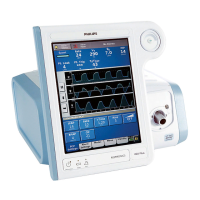
Do you have a question about the Philips V60 and is the answer not in the manual?
| Brand | Philips |
|---|---|
| Model | V60 |
| Type | Ventilator |
| Frequency | 50/60 Hz |
| Patient Types | Adult, Pediatric |
| Voltage | 100 to 240 VAC |
| O2 concentration | 21 to 100 % |
| Ventilation Modes | PC, SIMV |
Explains safety terms, general warnings, and steps for preparing the ventilator for use.
Covers operational aspects, alarm management, and care procedures.
Details first-time installation, communication interfaces, and diagnostic mode.
Explains symbols used on the ventilator and its graphical user interface.
Specifies the ventilator's intended use, patient population, contraindications, and potential side effects.
Provides an overview of the ventilator's features, modes, and physical components.
Explains the backup battery and how to navigate the ventilator's graphical interface.
Step-by-step guide for safely powering the ventilator on and off.
Explains the ventilator's system architecture and gas delivery mechanics.
Details breath delivery mechanisms including control variables, triggering, and cycling.
Focuses on the Auto-Trak algorithm for leak compensation and patient synchrony.
Summarizes the principles and characteristics of various ventilation modes.
Instructions for connecting oxygen supplies and installing an analyzer.
Steps for AC power connection and patient circuit setup.
Guides on connecting external devices and performing essential pre-use checks.
Procedures for running alarm tests and using the ventilator during transport.
Guidelines for storing the ventilator and important MRI safety warnings.
Procedures for changing modes, control settings, and making batch changes.
How to use the Ramp Time function and the 100% O2 feature.
Setup, usage, and guidelines for the PPV ventilation mode.
How to change alarm settings and select patient interface/exhalation ports.
Explores menu options like brightness, loudness, info, and standby mode.
How to adjust Auto-Trak+ and access the help function.
Introduces HFT, lists precautions, and references circuit setup procedures.
Instructions for setting up nasal cannulas and transitioning to/from HFT.
Covers changing modes to HFT, adjusting settings, and understanding HFT-specific alarms.
Explains display symbols and lists key patient parameters monitored by the ventilator.
How to scale waveform axes and freeze/unfreeze waveforms.
General alarm response procedures and explanation of visual alarm cues.
Overview of alarms, how to adjust settings, silence, and reset them.
Guide to troubleshooting common issues and a detailed reference for alarms/messages.
Instructions for cleaning and disinfecting the ventilator's exterior and touchscreen.
Guidance on filter maintenance and battery removal/replacement.
Outlines the preventive maintenance schedule and information on service.
Guidelines for proper disposal and storage of the ventilator.
Tables detailing ranges, resolutions, and accuracies for control settings and parameters.
Details adjustable alarm ranges and menu window settings.
Describes functions available within the diagnostic mode.
Covers physical, environmental, and pneumatic specifications.
Details electrical, accessory, alarm-related, and other specifications.
Steps for unpacking, inspecting, and mounting the ventilator.
Procedures for installing the battery and AC power cord.
Steps to confirm proper operation, alarms, and configure system settings.
Identifies interface ports and provides warnings about connections.
Details the RS-232 port, protocols, and connecting to Philips monitors.
Explains data display mapping and the remote alarm port functionality.
Lists compatible patient interfaces, including those for High Flow Therapy.
Lists compatible O2 analyzers and patient breathing circuits.
Lists compatible humidifiers, filters, nebulizers, and operator maintenance parts.
Lists other compatible parts and how to find ordering information.
Discusses EMC requirements, emissions, and potential interference.
Outlines immunity test levels and recommended separation distances for RF equipment.
Details device classification, safety standards, and component types.
Step-by-step instructions on how to access the diagnostic mode.
Overview of functions available within the System Settings menu like language, date/time.
How to enable software options, set baud rate, and manage alarm volume escalation.
Accessing the event log and performing touchscreen calibration.
How to safely exit the diagnostic mode.
Definitions of terms from A to CPAP, covering basic concepts and settings.
Definitions of terms from Cycle to HFT, covering technical terms and modes.
Definitions of terms from hPa to Max E, covering measurements and settings.
Definitions of terms from Max P to PPV, covering pressure and ventilation settings.
Definitions of terms from psi to S/T mode, covering units, protocols, and modes.
Definitions of terms from Time Trigger to VT, covering timing, leaks, and volume.
Alphabetical index for topics starting with A, B, and C.
Alphabetical index for topics starting with D, E, and F.
Alphabetical index for topics starting with G, H, and I.
Alphabetical index for topics starting with L, M, N, and O.
Alphabetical index for topics starting with P, R, and S.
Alphabetical index for topics starting with T and V.